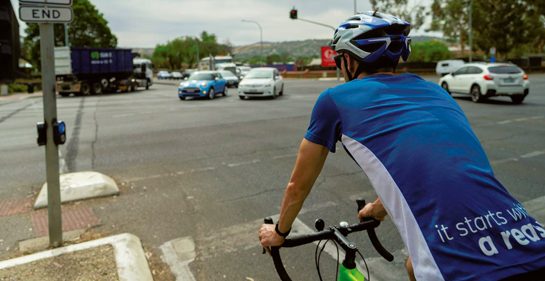Cyclists’ road rage fears

Cycling has become a big part of our lifestyles, but whether you ride to work or for pleasure, sometimes other road users’ behaviour can impact your journey.
Shockingly, RAA’s 2022 Risky Rides report revealed that three-quarters of South Australian cyclists have been a victim of road rage, including verbal abuse or rude hand gestures. Less than half of the 400 cyclists surveyed said they felt safe sharing the road with drivers.
The latest Risky Rides survey didn’t just ask cyclists about their experiences on the road but also about the quality of cycling infrastructure. Here are the results.
What we asked
RAA’s 2022 Risky Rides survey asked cyclists to nominate specific infrastructure gaps, such as missing cycling lanes or tricky intersections, that made them feel unsafe or caused them to choose riskier routes. The survey received 761 Risky Rides nominations, which focused on roads, paths and public spaces.
Top 5 nominated roads
Top 5 nominated paths and public spaces
What we discovered about cycling safety
About 94% of respondents reported they had experienced vehicles getting too close while riding, and 30% said they had been knocked off their bike by a car. As mentioned earlier, less than half felt safe on the road and 75% had experienced road rage.

Other South Australian cycling data from the report
- Approximately 160,000 RAA members have cycled in the past year.
- Twenty-three cyclists were killed and 2,287 injured in a road crash between 2017 and 2021.
- Casualty crashes in metropolitan Adelaide involved a cyclist on 13.3% of occasions.
- One in seven metropolitan Adelaide cyclist casualties between 2017 and 2021 occurred on the top 10 nominated roads.
RAA Senior Traffic Engineer Matthew Vertudaches said the report’s findings were concerning.
“Some drivers might feel frustrated at being slowed down by a cyclist, but there is never an excuse to let your emotions take over and abuse or endanger other road users – regardless of if you drive or cycle,” Mr Vertudaches said.
“These results underscore RAA’s call for increased investment in cycling infrastructure in South Australia, including more physical separation between cyclists and motor vehicles.
“With South Australia having the second-lowest cycling participation of any Australian state or territory, continuous and safe infrastructure is key to addressing this and improving safety for cyclists.”
Array|Array|Array|Array|Array
